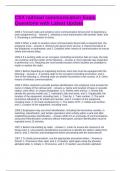CSX railroad communication Exam
Questions with Latest Update
1005.1 Test each radio and wireless voice communication device prior to beginning a
work assignment by: - Answer-1. Initiating a voice transmission with another radio, and
2. Receiving a confirmation of clarity.
1005.2 When a radio or wireless voice communication device fails a required test, the
employee must: - Answer-1. Remove the device from service, 2. Report the failure to
the dispatcher or yardmaster, and 3. Establish other means of communication to ensure
safety and reduce delay.
1005.3 If a working radio on an occupied, controlling locomotive fails en route, the train
can continue until the earlier of the following: - Answer-a. Next calendar day inspection
is performed, or b. Reaching the next forward location where facilities are available to
repair or replace the radio.
1004.1 Before departing an originating terminal, each train must be equipped with the
following: - Answer-1. A working radio in the occupied controlling locomotive, and 2.
One of the following: a. Working radio on another locomotive in the consist, or b. Other
means of wireless communications.
1006.1 When required to provide positive identification, the employee must provide the
name or initials of the railroad and: - Answer-a. Name and location of base or wayside
station, yard office, or unique designation, or b. Mobile radio unit by: 1. Words that
identify the precise mobile unit, 2. Individual's title and name, and 3. If applicable, the
location of the equipment, including track. c. Train by: 1. Train number, 2. The word
locomotive followed by its initials and number, and 3. Location of the equipment,
including track. d. On-track equipment by: 1. The letters OTE, 2. Initials and number,
and 3. Location of the equipment, including track.
1006.2 Employees may use short identification, including the locomotive number, in
switching, classification, and similar operations when wholly within a yard and after
establishing positive identification. - Answer-1006.3 If an exchange of communications
using short identification continues without interruption, positive identification must be
repeated every 15 minutes.
1007.1 Before transmitting by radio: - Answer-1. Listen to ensure the channel is not
being used, 2. Use positive identification procedures to identify the station calling from
and to, and 3. Receive acknowledgment before proceeding with the transmission.
1007.2 To clarify pronunciation, use the appropriate procedure below: - Answer-a.
Words: 1. Pronounce then spell, and 2. If needed, spell again using the phonetic
alphabet table. b. Initials: 1. Pronounce, and 2. If needed, use phonetic alphabet.
, 1007.3 State numbers by: - Answer-1. Digit, 2. Decimal point by the word point or dot,
and 3. Exact multiples of hundreds and thousands.
1008.1 Do not act on a radio communication if: - Answer-a. Misunderstood, or b. Not
completed, or c. Not in compliance with operating rules.
1008.2 Promptly acknowledge radio transmissions by using positive identification unless
doing so would interfere with safety. Repeat the transmission, except when it: - Answer-
a. Relates to yard switching operations, or b. Is a recorded message from an automatic
alarm device, or c. Is general in nature and does not contain any information,
instructions, or advice affecting railroad safety or train movement.
1008.3 Repeat radio communications from the train dispatcher that govern the
movement of trains or on- track equipment on controlled tracks. Before acting upon any
instructions, both parties must: - Answer-1. Confirm their mutual understanding of the
communication, and 2. Give their initials to the other party.
1008.4 End all radio transmissions not related to yard switching with the following: -
Answer-a. The word OVER when a response is required, or b. Positive identification
followed by the word OUT when a response is not required.
1009.1 Employees operating moving trains or equipment must not copy or repeat
copied information. - Answer-...
1009.2 Information that is required to be copied must only be transmitted to moving
equipment when: - Answer-1. It can be received and copied without impairing safety, 2.
Receiving employee is not operating the controls of the equipment, and 3. Restriction is
not within 3 miles unless: 1. Movement has been stopped, and 2. Employee operating
the controls of the equipment has been advised of the situation and can comply.
1009.3 Follow the procedure below for transmitting and repeating mandatory directives:
1 Train Dispatcher
Call the employee or train addressed and state the intention to transmit a mandatory
directive.
2 Receiving Employee
State title, name, and location. Confirm being prepared to receive mandatory directive.
3 Train Dispatcher
State name of person copying mandatory directive. Transmit the mandatory directive. -
Answer-4 Receiving Employee
Copy the mandatory directive in writing on the prescribed form and in the prescribed
format. Read back to the train dispatcher what has been written.
5 Train Dispatcher
Ensure accuracy of repeated directive. State time and initials of employee authorized to
issue mandatory directives.
6 Receiving Employee




